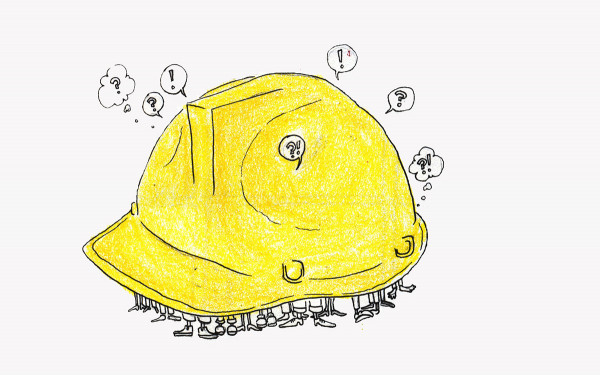How Can Montreal Become Bike-Friendly?
“Be as safe as you want, but it’s not always up to you. There’s a saying that graveyards are full of people who had the right of way,” says Paul Rozehnal, a bike messenger working in Montreal.
“You can’t slip, definitely,” he continued. “And every morning, I kind of like, remind myself. And there’s certain things—like every time I see roadkill, every time I go under an underpass, the white bikes, they all remind me.”
White bikes are spray painted in memoriam to people who have been killed while riding, like Justine Charland St-Amour, 24, who was struck and killed only a few weeks ago by a truck.
“Sharing the road in the way that Montreal does is a little bit like a war because you need a fast bike—if you’re biking on the road you kind of feel like you’re being hunted.”
Rozehnal said he was hit once while working in the rain. “I was hit very lightly, but it was still enough to knock my head and have it be a very real reminder that there’s crazy people on the road and we share a space with them.”
In the summertime, drivers are more aware of those they have to share a road with, but the risk factor only goes up as temperatures fall. “It becomes much less safe to be on a bike [in the winter] because there’s like power in numbers,” said Rozehnal.
In a press conference, Mayor Denis Coderre proposed photo radars in dangerous areas of the city and called for changes to the Quebec Highway Safety Code. Changes to the code have already included pricier fines for dooring cyclists, but that’s only if police officers side with riders in accidents and hand out tickets. Unlike progressive cyclist countries like the Netherlands, the law is not always pro-cyclist in Montreal.
For a city like Montreal that promotes alternative transport options, conditions should be improved. The city joined the modern trend with other metropolitan cities to promote a culture of biking and eco-friendly transportation after they introduced the widely popular BIXI bike sharing system in 2007. But while the city will provide bikes, you’re on your own when it comes to arriving to your destination safely.
If you claim that you are bike friendly, you have a responsibility to create an environment safe for bikes. Although crashes are reported, Montreal statistically scores very well when it comes to bike accidents per 100,000 rides—it’s only two annually according to a 2015 study by Pembina Institute. But small collisions like side swiping, or slamming on your brakes, or having to narrowly escape a turning car, or even getting doored, go unreported and aren’t represented statistically.
According to CAA Bike Safety, 7,500 Canadian bikers are seriously injured every year, with ‘serious injury’ being defined as “fractures, concussions, internal lesions, crushing, severe cuts and laceration, severe general shock requiring medical treatment and any other serious lesions entailing detention in hospital.”
The city has some segregated cycling facilities on the sides of major roads. The total biking infrastructure the city has racks up to 648 kilometres, an impressive figure, but a far second to Calgary’s 1032 kilometres, according to Pembina’s study. But while east to west travel in the downtown area is focused on, it’s not enough. North to south travel infrastructure in and near the downtown core desperately needs to be improved.
It’s horrible to ride north on streets like St. Laurent and St. Denis, as they both have no type of separated line or lane. On top of the added complexities of the construction on northern St. Denis, it makes the street almost impossible to travel on. As a bike messenger, Rozehnal says he just avoids taking certain streets in the summertime point blank, like Ste. Catherine St. and Duke St.
Aside from infrastructure additions and modifications, a call for attention to bikers would be useful as well. Bikers’ jobs are not to be invisible. When we truly share the road as community members and give attention to the two-wheeled details, everyone wins. Even city signs reading “watch for bikers”—similar to the hundreds of construction signs all over the city—would bring another level of awareness to the minds of pedestrians and drivers.
Montreal should also consider new left-turn laws. During peak traffic, busy streets—like those that branch off from Ste. Catherine St. and De Maisonneuve Blvd.—should designate time for cars to make left turns instead of competing with foot traffic and bikers.
As a driver, it’s sometimes difficult to wait for a break in the foot traffic. It becomes difficult on a whole other level when you have to cut through bikers who ride through the green light, and walkers who don’t give drivers a break to pass through the crosswalk. It’s a complicated game of high stakes Frogger that can too easily end with a serious accident—a true game over for either biker or walker. It would benefit everyone if left turns had a new procedure and the basic traffic direction was reevaluated with bikers in mind.
Biking is wonderful. All we’re asking is to have the city on bikers’ side, to watch our backs for us, so we can focus more on enjoying the ride than making sure we make it to our destination without hurting ourselves or others.
Correction: In a previous iteration of this article, Paul Rozehnal’s name was misspelled. The Link regrets the error.

_600_832_s.png)



_600_375_90_s_c1.jpg)
2_600_375_90_s_c1.jpg)